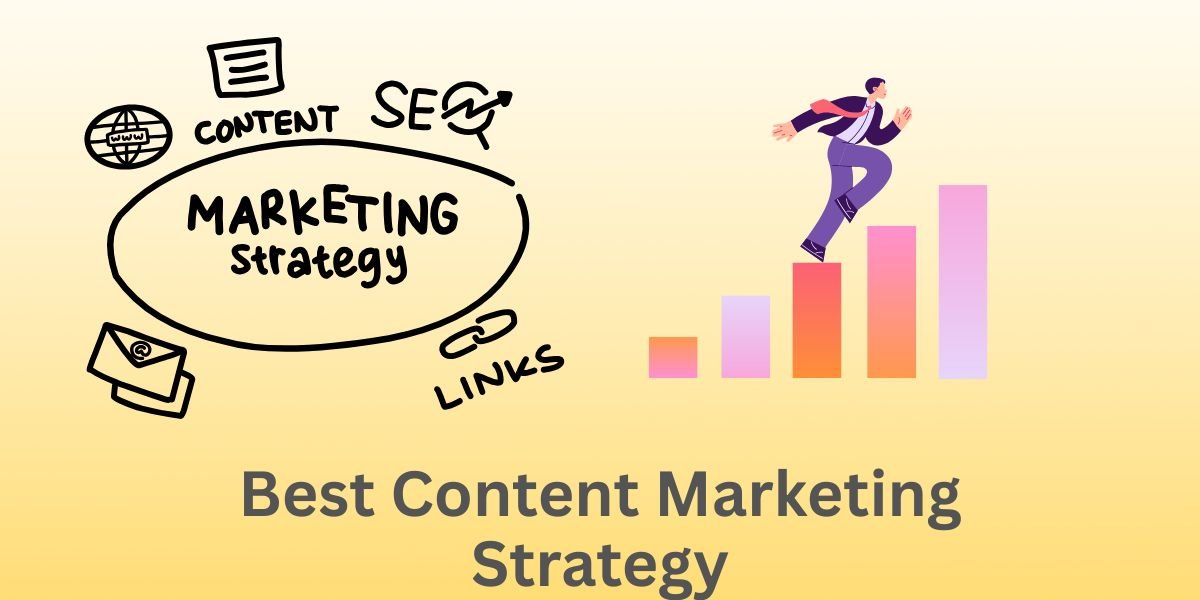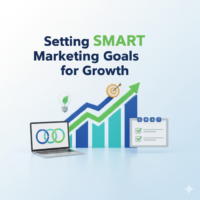How to Improve Your Content Marketing Strategy: A Complete Step-by-Step Guide
Published: 24 Sep 2025
Content marketing strategy has become one of the most powerful ways to attract, engage, and convert customers. But here’s the truth—many campaigns fail because they lack a clear strategy.
Why? Some brands create random posts without goals. Others don’t understand their audience or forget to promote their content. The result is wasted time and effort.

The good news? With the right strategy, you can turn content into a long-term growth engine. In this guide, we’ll explore practical steps, real examples, and proven tactics to improve your content marketing campaigns and get results that last.
What is Content Marketing and Why Does it Matter
Content marketing is a strategy focused on creating and sharing valuable, relevant content to attract and engage a target audience.
Instead of pushing ads, it offers solutions, insights, or entertainment people genuinely want.
The goal is to build trust and long-term relationships with your audience.
Over time, this drives actions like purchases, subscriptions, and brand loyalty.
Why it matters:
- It builds trust with your audience.
- It increases brand awareness.
- It drives traffic to your website.
- It helps you generate leads and sales without sounding “salesy.”
Example 1:
- Imagine a skincare brand. Instead of only posting product ads, they share blogs like “5 Tips to Get Clear Skin Naturally” or short Instagram videos explaining skincare routines. People start following them, trusting them, and eventually buying from them.
Example 2:
- A travel agency could publish guides like “Top 10 Hidden Gems in Europe”. Travelers read these guides, get inspired, and then book tours with the agency.
So, content marketing works because it makes your brand helpful first, promotional second.
How to Improve Your Content Marketing Strategy
Some of the most effective and repeatedly tested methods of improving your content marketing strategy are given below:
Understand Your Audience Deeply
Before creating any content, you must know who you’re talking to and what they really want. Without this step, even great content can miss the mark.
Build Buyer Personas
A buyer persona is a simple profile of your ideal customer. It includes:
- Demographics — age, gender, location, job title, income.
- Pain points — what problems they’re trying to solve.
- Goals & interests — what they want to achieve.
Example:
For a fitness brand targeting busy professionals:
- Age: 25–40
- Job: Office workers with long hours
- Pain points: No time for gym, sitting too much, stress
- Goal: Quick workouts, healthy meals on the go
Research Methods to Know Your Audience
- Analytics — Check Google Analytics or social media insights to see who’s already visiting your site (age, location, devices used).
- Surveys & polls — Ask your audience directly what they struggle with.
- Social listening — Watch conversations on platforms like Reddit, Facebook groups, or X (Twitter) to find what people ask or complain about.
- Keyword intent — Use SEO tools to see what people search for and why (e.g., “best 15-minute workouts at home”).
Why This Matters
When you know your audience:
- You create content that solves real problems.
- Your headlines and visuals feel personal.
- Your conversion rate improves because people feel understood.
Quick example:
A fitness brand that learns its audience wants quick home workouts can make a series like “7-Minute Desk Exercises for Office Workers”. This resonates far better than random generic gym tips.
Audit Your Current Content
Before creating new content, it’s smart to look at what you already have. A content audit helps you see what’s working, what’s outdated, and what needs improvement.
Why a Content Audit Matters
- Saves time — you might already have good posts you can refresh instead of starting from scratch.
- Improves SEO — updating old content can boost rankings and traffic.
- Spots gaps — shows topics you haven’t covered yet.
- Strengthens your brand — removes low-quality or irrelevant posts.
How to Audit Your Content Step by Step
- Collect all your content
- Make a list of your blog posts, videos, social media posts, or podcasts.
- Use a spreadsheet or SEO tool like Ahrefs or SEMrush to track pages.
- Check performance
- Look at traffic (Google Analytics, Search Console).
- Note engagement — comments, shares, average time on page.
- Check conversion — which posts lead to sign-ups or sales.
- Review quality
- Is the information still accurate?
- Is the design or formatting user-friendly?
- Does it target the right keywords and intent?
- Decide what to do
- Keep content that’s performing well.
- Update posts that rank but need fresh stats, images, or keywords.
- Merge similar low-traffic posts into one strong article.
- Remove thin or outdated content that doesn’t serve your audience.
Example
Suppose you run a travel blog. You might find:
- Your post “Best Travel Apps in 2019” gets little traffic now — update it to “Top Travel Apps for 2025.”
- Two posts about “Packing Tips” overlap — combine them into one ultimate packing guide.
- An old article about a closed airline route — remove it.
Set Clear Content Marketing Goals
Great content needs a clear purpose. If you don’t know what you want to achieve, it’s easy to waste time creating posts that don’t move your business forward.
Why Goals Matter
- Keep you focused on what really matters.
- Make it easier to measure success and adjust your strategy.
- Help your whole team work toward the same results.
How to Set Strong Content Goals
- Align with your business objectives
- If your business wants more leads → focus on content that builds trust and encourages sign-ups.
- If your goal is brand awareness → create content that reaches new people (e.g., shareable infographics, trending posts).
- Use SMART goals(Specific, Measurable, Achievable, Relevant, Time-bound)
- ✅ Example: “Increase blog traffic by 30% in the next 6 months.”
- ✅ Example: “Get 500 email sign-ups from content downloads in 3 months.”
- Pick the right metrics
- Traffic & reach: page views, impressions, new visitors.
- Engagement: comments, shares, average time on page.
- Conversions: newsletter sign-ups, demo requests, sales.
Example
If you run an online fitness coaching business:
- Business goal → get more paying clients.
- Content goal → publish 4 blog posts a month that answer questions busy professionals have about fitness (e.g., “How to work out in 15 minutes a day”).
- Success metric → 200 new email subscribers in 3 months who can be nurtured into clients.
Plan and Map Your Content
Once you know your audience and your goals, it’s time to plan what content to create and when to share it. A clear plan keeps your efforts organized and prevents last-minute stress.
How to Plan and Map Your Content
- Create a Content Calendar
- A content calendar helps you see everything at a glance — topics, formats, and publish dates.
- Use tools like Trello, Asana, Notion, or Google Sheets.
- Add columns for:
- Topic / Title
- Format (blog, video, social post, infographic)
- Target keywords
- Publish date
- Promotion channels
- Map Content to Funnel Stages
Each stage of the marketing funnel needs different content:- Awareness: Blog posts, how-to guides, infographics (e.g., “5 Quick Stretches for Desk Workers”).
- Consideration: Comparison posts, expert interviews, webinars (e.g., “Personal Trainer vs. Online Coach — Which is Better for Busy People?”).
- Conversion: Case studies, testimonials, free trials (e.g., “How Sarah Lost 15 lbs in 3 Months with Our Program”).
- Retention: Email tips, loyalty programs, exclusive content (e.g., “VIP Workout Challenge for Subscribers”).
- Balance Content Types
- Mix formats to keep your audience engaged.
- Examples: blog posts, videos, podcasts, short social media reels, newsletters, and infographics.
- Repurpose Content
- Turn one blog post into multiple formats to save time:
- Blog → LinkedIn post → Instagram carousel → YouTube short → Email newsletter.
- Turn one blog post into multiple formats to save time:
Example
A fitness brand targeting busy professionals might:
- Post 2 blog articles monthly, answering time-saving workout questions.
- Share short workout tip videos twice a week on Instagram & TikTok.
- Send a weekly newsletter with success stories and tips.
Choose the Right Content Types & Channels
Your content will only work if it’s delivered in the right format and on the right platforms where your audience spends time.
How to choose wisely:
- Look at your buyer personas — Where do they hang out online? What do they like to consume?
- Test different formats — blogs, videos, podcasts, social media posts, webinars, etc.
- Consider your resources — Don’t try to do everything; focus on what you can do well.
Examples:
- A B2B software company might create LinkedIn articles, case studies, and webinars because its audience is professionals.
- A fashion brand might focus on Instagram Reels, Pinterest boards, and style guides on its blog.
- A fitness trainer might use YouTube workouts, Instagram tips, and a free email course.
Promote and Distribute Content
Great content won’t perform if no one sees it. Promotion is where your hard work pays off.
Ways to promote:
- Social media sharing — Post on your own channels. Use stories, carousels, or short videos.
- Email newsletters — Send your best new content to subscribers.
- Paid ads — Boost important content on Facebook, Instagram, or Google Ads.
- Communities & forums — Share helpful posts on Reddit, Quora, or LinkedIn groups.
- Collaborations & partnerships — Work with influencers or other brands to reach new audiences.
Example:
If you publish a blog post, “10 Quick Healthy Lunch Ideas”:
- Please share it on Instagram stories and Pinterest with visuals.
- Email it to your subscribers with a short note: “Need quick lunch ideas? We’ve got you.”
- Run a small Facebook ad targeting busy parents.
Measure, Analyze & Improve
Content marketing is not “set it and forget it.” You need to track results and adjust.
Important metrics to track:
- Traffic: Are people visiting your site? (Google Analytics)
- Engagement: Are they reading, liking, sharing? (time on page, comments, shares)
- Leads & conversions: Are they signing up, buying, or downloading?
- SEO performance: Are your keywords ranking better?
Example:
If your how-to blog gets traffic but no one subscribes to your newsletter, add a free downloadable checklist to encourage sign-ups.
If Instagram videos work better than long YouTube videos, invest more time in short-form content.
Keep Learning & Adapting
Marketing changes quickly. Stay flexible and keep improving.
Ways to stay updated:
- Follow top marketers and SEO blogs like HubSpot, Neil Patel, or Ahrefs.
- Test new trends — AI tools, interactive content, podcasts, or short-form videos.
- Study your competitors — what content gets them engagement?
- Listen to your audience — their comments and questions can inspire your next post.
Example:
If you run a travel blog and notice people asking about budget travel in 2025, create new posts and videos on that topic before your competitors.
Final Thoughts
Improving your content marketing strategy isn’t about doing everything at once — it’s about doing the right things step by step. Understand your audience, set clear goals, create valuable content, promote it smartly, measure results, and keep improving.
If you treat content like a long-term investment, you’ll build trust, attract loyal customers, and grow your business steadily.

- Be Respectful
- Stay Relevant
- Stay Positive
- True Feedback
- Encourage Discussion
- Avoid Spamming
- No Fake News
- Don't Copy-Paste
- No Personal Attacks

- Be Respectful
- Stay Relevant
- Stay Positive
- True Feedback
- Encourage Discussion
- Avoid Spamming
- No Fake News
- Don't Copy-Paste
- No Personal Attacks




